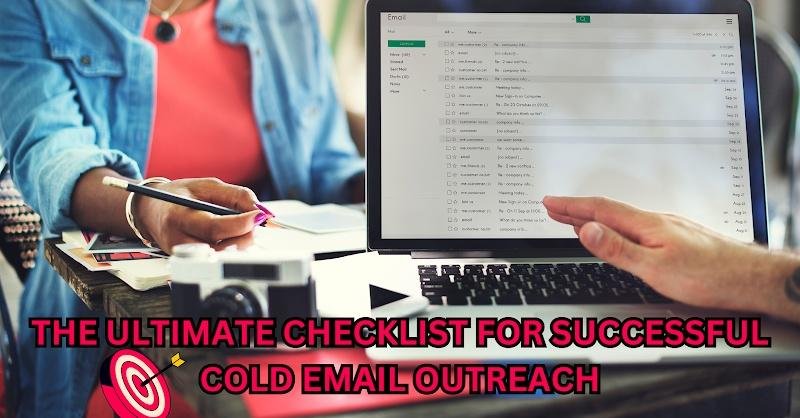Ever wondered why your business fails in cold email outreach? The ultimate checklist for successful cold email outreach is one powerful tool that enables businesses to grow network building and conversion of leads for actual conversions.
With the fast-growing inboxes, reaching out via cold email has to be highly strategic. This checklist will take you through the necessary steps required to make a successful cold email campaign stand out and deliver results.
Identifying and Refining Your Target Audience
The foundation of any successful cold email campaign lies in understanding who you’re reaching out to. Let’s dive into the key aspects of audience targeting:
- Demographics: Age, location, job title, industry
- Pain points: What challenges does your audience face?
- Goals: What are they trying to achieve?
The Power of Audience Segmentation
Segmenting your audience to effectively reach them more effectively. Categorizing your prospects by industry, company size, geographical location, and behavior gives you the ability to craft messaging that resonates, driving deeper engagement, conversion, and customer satisfaction.
Crafting a Compelling Subject Line
Once you have identified your audience, very importantly, the next step is to engage them with an irresistible subject line. Understanding what is a cold email and what are its challenges will come in handy in this respect of email recipient’s open emails based solely on the subject line!
Creating Attention-Grabbing Subject Lines
Keep your subject lines concise to grab attention. Use powerful words to create excitement and urgency, motivating immediate action. Ask a question to pique curiosity and encourage openness.
The Power of A/B Testing
Don’t rely on assumptions when writing subject lines. Instead, conduct A/B testing with subject line variations to see which one works better in terms of open rates. Take the results and apply them to craft your subject lines for maximum effect with your audience.
Common Subject Line Mistakes to Avoid
Being too vague in your subject lines. All caps can be considered yelling, and too much punctuation can be a distraction. Make sure the content matches the promise of your subject line so that you are not misleading your audience.
Personalizing the Email for Maximum Engagement
Perfecting your subject line is just the beginning, the next step is crafting a message that speaks directly to your recipient. Here’s how to make your emails feel more personal and relevant:
The Power of Personalization
- Use Their Name: Start with “Hi [First Name],” to create an immediate connection, rather than the impersonal “Dear Sir/Madam.”
- Reference Their Company: Include something specific like, “I noticed [Company Name] recently…” to show that your message is tailored to them.
- Mention Recent Achievements: Acknowledge their successes with, “Congratulations on your recent [achievement].”
Using Data Points to Tailor Your Message
- Draw on recent company news, LinkedIn activities, and industry trends to make your emails more relevant and demonstrate your understanding of their needs. This approach can significantly increase engagement and conversion rates.
Balancing Personalization with Scalability
- Personalization is key, but for large outreach campaigns, it’s crucial to find a balance:
- Use templates with customizable fields to streamline the process.
- Employ cold email outreach software to automate personalization.
- Create persona-based templates for different segments to maintain relevance and boost engagement.
Creating a Clear and Actionable (CTA)
With personalization grabbing your recipient’s attention, the next step is ensuring they know what to do next. Make your CTA specific, urgent, and easy to follow. This will guide the recipient towards the desired action and increase your chances of conversion.
Best Practices for Writing Effective CTAs
Use action-oriented verbs in your CTAs to encourage specific actions. Create a sense of urgency to motivate immediate action. Focus on the benefits that the recipient will gain from taking action. Keep your CTAs concise for maximum impact.
Making CTAs Stand Out
- Use contrasting colors
- Place CTAs strategically (e.g., after key benefits)
- Make buttons large enough to click on mobile devices
Testing and Optimising CTA Placement
Experiment with different CTA placements within your email to determine the most effective location. Test multiple CTAs to see which ones drive the highest click-through rates. Analyse click-through rate data to identify the most effective placement for your CTAs.
Ensuring Email Deliverability
Even with a well-written email and a clear CTA, none of it matters if your message doesn’t reach the inbox. Ensuring email deliverability is essential for maximizing your outreach success.
Strategies to Avoid Spam Filters
Avoid spam trigger words in your subject lines and email content. Maintain a good sender reputation by consistently sending valuable content. Use authentication protocols like SPF, DKIM, and DMARC to improve deliverability and reduce spam filters.
Maintaining a Healthy Email List
Maintain a clean email list by regularly removing inactive subscribers. Use double opt-in to confirm new subscribers. Monitor bounce rates and remove invalid addresses to improve deliverability and engagement.
Best Practices for Optimising Email Deliverability
Warm up your IP address by gradually increasing your sending volume. Segment your email list to send relevant content and improve engagement. Monitor your sender score using specialized tools to ensure deliverability.
Timing and Frequency of Cold Email Campaigns
Beyond deliverability, the timing and frequency of your emails can significantly affect their effectiveness. Understanding the optimal timing and frequency is key to maximizing your outreach success.
Understanding Optimal Sending Times
When sending emails globally, consider time zones and segment by region. Analyse industry patterns to determine optimal times for B2B and B2C audiences. Experiment with different days and times through A/B testing to find the most effective sending windows.
Frequency of Follow-up Emails
Follow up consistently to maintain interest. Send a first follow-up 2-3 days after the initial email. Subsequent follow-ups should be spaced out 4-7 days apart. Aim for 3-5 follow-ups in a sequence to increase engagement and conversions.
Leveraging Automation Tools
To schedule emails at optimal times, automate follow-up sequences, and pause campaigns when a response is received. This streamlines your outreach process and ensures timely and personalized communication.
Follow-up Strategies that Drive Conversions
Sending an email at the right time is important, but structured follow-up strategies are equally crucial to keep your audience engaged without overwhelming them. When following up, reference your original email to remind them of your outreach and provide additional value by sharing relevant case studies or resources.
Keep your messages brief to respect their time and vary your approach in each follow-up to maintain interest and increase response likelihood. For timing, follow up consistently with a first follow-up 2-3 days after the initial email, a second follow-up 4-7 days later, and a final follow-up 7-14 days after the second to help increase engagement and conversions.
Also, don’t limit your outreach to email alone, explore other channels like LinkedIn to connect directly, engage with their content on social media, or leave a voicemail to personalize your message and enhance the chances of a response.
Analyzing and Iterating on Email Outreach Performance
With a solid follow-up strategy in place, the next step is to measure your results. By tracking key metrics like open rates and click-through rates, you can continuously improve your outreach strategy to achieve even better outcomes.
Key Metrics to Track
- Open Rate: Measure subject line effectiveness
- Click-Through Rate (CTR): Gauge content and CTA appeal
- Response Rate: Assess overall campaign effectiveness
- Conversion Rate: Track ultimate goal achievement
Using Data to Refine Your Approach
Identify patterns in successful emails to understand what resonates with your audience. Analyse subject line performance to optimize open rates. Determine optimal sending times based on when your audience is most likely to engage with your emails.
Conclusion
Mastering cold email outreach is an ongoing process of refinement and optimization. By following this comprehensive checklist, you’ll be well set to create compelling, personalized campaigns that resonate with your target audience and drive real results.
Indeed, your success will be based on understanding your audience, crafting appealing content, and ongoing analysis and enhancement. Stick to persistence and strategic implementation of the best practices, and you’ll find how cold email campaigns finally get transformed into powerful tools for business growth.
Frequently Asked Questions
- What are the 4 T’s to help you have a strong and compelling email?
- Target: Know your audience
- Topic: Have a clear, relevant subject
- Timing: Send at the right moment
- Tone: Use appropriate language and style
- What makes cold calling and email marketing successful?
Cold calling and email marketing succeed when they are targeted, personalized, and offer value. In cold calling, a clear script and good listening skills help engage the prospect. In email marketing, a compelling subject line and concise, relevant content grab attention. Consistent follow-up also boosts success.
- What is the best method for cold outreach?
The best method for cold outreach is to personalize your message, keep it short, and focus on the recipient’s needs. Use email or LinkedIn, introduce yourself briefly, explain how you can help, and include a clear call to action. Following up politely increases the chances of a response.










